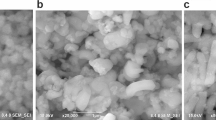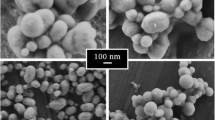Abstract
The synthesis of mesoporous silica nanoparticles (MSNs), widely investigated for application in nanomedicine, depends on many experimental factors and lacks reproducibility. Furthermore, its mechanism is not fully understood, in particular for the chemistry of the hydrolysis and condensation of tetraethoxysilane (TEOS). We coupled simple pH measurements with light diffusion monitoring directly within the reaction vessel in order to understand the early stages of the synthesis until the formation of nanoparticles. We found that two regimes of hydrolysis can be detected before the nanoparticles are formed. At the turning point, only 28% of the TEOS molecules are singly hydrolyzed and the condensation reaction only starts after the aggregation of the silicate-surfactant micelles. Experimental factors such as stirring strength or presence of carbonates of sodium hydroxide exert a strong influence on the kinetics of MSNs formation and on their size, and must be carefully controlled for reproducibility. Based on all our experimental evidence and on previous literature reports, a formation mechanism was proposed in order to highlight the importance of the interplay between chemical and physicochemical processes in such a complex system.
Graphical Abstract

The synthesis of mesoporous silica nanoparticles was investigated by pH monitoring, which gives valuable complementary information to the currently accepted mechanism.
Highlights
-
pH monitoring coupled with light scattering measurements enable an understanding of the early stages of the synthesis of mesoporous silica nanoparticles promoted by sodium hydroxide.
-
The nucleation of the nanoparticles, the determining step to control their size, occurs within a minute after the initial tetraethoxysilane addition under basic conditions.
-
Two regimes of hydrolysis are observed initially, while the condensation reaction only starts after the nucleation of NPs.
-
Experimental factors such as stirring strength or presence of carbonates in sodium hydroxide must be carefully controlled for reproducibility.






Similar content being viewed by others
References
Vallet-Regí M, Schüth F, Lozano D et al. (2022) Engineering mesoporous silica nanoparticles for drug delivery: where are we after two decades. Chem Soc Rev 51:5365–5451. https://doi.org/10.1039/D1CS00659B
Kachbouri S, Elaloui E, Charnay C (2022) Synthesis and characterization of a new silica nanoparticles using APG/CTAB as modified agent. J Sol-Gel Sci Technol 103:39–49. https://doi.org/10.1007/s10971-022-05802-3
Beltrán-Osuna ÁA, Perilla JE (2016) Colloidal and spherical mesoporous silica particles: synthesis and new technologies for delivery applications. J Sol-Gel Sci Technol 77:480–496. https://doi.org/10.1007/s10971-015-3874-2
Wu S-H, Mou C-Y, Lin H-P (2013) Synthesis of mesoporous silica nanoparticles. Chem Soc Rev 42:3862–3875. https://doi.org/10.1039/C3CS35405A
Pal N, Lee J-H, Cho E-B (2020) Recent trends in morphology-controlled synthesis and application of mesoporous silica nanoparticles. Nanomaterials 10:2122
Florensa M, Llenas M, Medina-Gutiérrez E et al. (2022) Key parameters for the rational design, synthesis, and functionalization of biocompatible mesoporous silica nanoparticles. Pharmaceutics 14:2703
Lai C-Y, Trewyn BG, Jeftinija DM et al. (2003) A Mesoporous silica nanosphere-based carrier system with chemically removable cds nanoparticle caps for stimuli-responsive controlled release of neurotransmitters and drug molecules. J Am Chem Soc 125:4451–4459. https://doi.org/10.1021/ja028650l
Catalano F, Pompa PP (2019) Design rules for mesoporous silica toward the nanosize: a systematic study. ACS Appl Mater Interfaces 11:47237–47246. https://doi.org/10.1021/acsami.9b16135
Kim M-K, Ki D-H, Na Y-G et al. (2021) Optimization of mesoporous silica nanoparticles through statistical design of experiment and the application for the anticancer drug. Pharmaceutics 13:184. https://doi.org/10.3390/pharmaceutics13020184
Castillo RR, de la Torre L, García-Ochoa F et al. (2020) Production of MCM-41 nanoparticles with control of particle size and structural properties: optimizing operational conditions during scale-up. Int J Mol Sci 21:7899
Varache M, Bezverkhyy I, Saviot L et al. (2015) Optimization of MCM-41 type silica nanoparticles for biological applications: control of size and absence of aggregation and cell cytotoxicity. J Non-Cryst Solids 408:87–97. https://doi.org/10.1016/j.jnoncrysol.2014.10.020
Ribeiro T, Rodrigues AS, Calderon S et al. (2020) Silica nanocarriers with user-defined precise diameters by controlled template self-assembly. J Colloid Interface Sci 561:609–619. https://doi.org/10.1016/j.jcis.2019.11.036
Varache M, Bezverkhyy I, Bouyer F et al. (2015) Improving structural stability of water-dispersed MCM-41 silica nanoparticles through post-synthesis pH aging process. J Nanopart Res 17:356. https://doi.org/10.1007/s11051-015-3147-6
McNeil KJ, DiCaprio JA, Walsh DA, Pratt RF (1980) Kinetics and mechanism of hydrolysis of a silicate triester, tris(2-methoxyethoxy)phenylsilane. J Am Chem Soc 102:1859–1865. https://doi.org/10.1021/ja00526a015
Qiao Z-A, Zhang L, Guo M et al. (2009) Synthesis of mesoporous silica nanoparticles via controlled hydrolysis and condensation of silicon alkoxide. Chem Mater 21:3823–3829. https://doi.org/10.1021/cm901335k
Issa AA, Luyt AS (2019) Kinetics of alkoxysilanes and organoalkoxysilanes polymerization: a review. Polymers 11:537
Sadasivan S, Fowler CE, Khushalani D, Mann S (2002) Nucleation of MCM-41 nanoparticles by internal reorganization of disordered and nematic-like silica–surfactant clusters. Angew Chem Int Ed 41:2151–2153. 10.1002/1521-3773(20020617)
Hollamby MJ, Borisova D, Brown P et al. (2012) Growth of mesoporous silica nanoparticles monitored by time-resolved small-angle neutron scattering. Langmuir 28:4425–4433. https://doi.org/10.1021/la203097x
Cabrera S, El Haskouri J, Guillem C et al. (2000) Generalised syntheses of ordered mesoporous oxides: the atrane route. Solid State Sci 2:405–420. https://doi.org/10.1016/S1293-2558(00)00152-7
Yi Z, Dumée LF, Garvey CJ et al. (2015) A new insight into growth mechanism and kinetics of mesoporous silica nanoparticles by in situ small angle X-ray scattering. Langmuir 31:8478–8487. https://doi.org/10.1021/acs.langmuir.5b01637
Blin JL, Impéror-Clerc M (2013) Mechanism of self-assembly in the synthesis of silica mesoporous materials: in situ studies by X-ray and neutron scattering. Chem Soc Rev 42:4071–4082. https://doi.org/10.1039/C2CS35362H
Colomer MT, Guzmán J, Moreno R (2008) Determination of peptization time of particulate sols using optical techniques: titania as a case study. Chem Mater 20:4161–4165. https://doi.org/10.1021/cm703560x
Bandura AV, Lvov SN (2005) The ionization constant of water over wide ranges of temperature and density. J Phys Chem Ref Data 35:15–30. https://doi.org/10.1063/1.1928231
Osterholtz FD, Pohl ER (1992) Kinetics of the hydrolysis and condensation of organofunctional alkoxysilanes: a review. J Adhes Sci Technol 6:127–149. https://doi.org/10.1163/156856192X00106
Cheng C-F, Luan Z, Klinowski J (1995) The role of surfactant micelles in the synthesis of the mesoporous molecular sieve MCM-41. Langmuir 11:2815–2819. https://doi.org/10.1021/la00007a075
Zana R, Frasch J, Soulard M et al. (1999) Fluorescence probing investigations of the mechanism of formation of organized mesoporous silica. Langmuir 15:2603–2606. https://doi.org/10.1021/la981603f
Beck JS, Vartuli JC, Roth WJ et al. (1992) A new family of mesoporous molecular sieves prepared with liquid crystal templates. J Am Chem Soc 114:10834–10843. https://doi.org/10.1021/ja00053a020
Kresge CT, Leonowicz ME, Roth WJ et al. (1992) Ordered mesoporous molecular sieves synthesized by a liquid-crystal template mechanism. Nature 359:710–712. https://doi.org/10.1038/359710a0
Raman NK, Anderson MT, Brinker CJ (1996) Template-based approaches to the preparation of amorphous, nanoporous silicas. Chem Mater 8:1682–1701. https://doi.org/10.1021/cm960138
Goyal PS, Dasannacharya BA, Kelkar VK et al. (1991) Shapes and sizes of micelles in CTAB solutions. Phys B Condens Matter 174:196–199. https://doi.org/10.1016/0921-4526(91)90606-F
Kuperkar K, Abezgauz L, Prasad K, Bahadur P (2010) Formation and growth of micelles in dilute aqueous CTAB solutions in the presence of NaNO3 and NaClO3. J Surfact Deterg 13:293–303. https://doi.org/10.1007/s11743-009-1173-z
Acknowledgements
Sabine Douillet and Dr. Jérôme Kieffer (ESRF) are gratefully acknowledged for their help.
Funding
This work was supported by the Agence Nationale de la Recherche (ANR-20-CE09-0017-03).
Author information
Authors and Affiliations
Contributions
All authors contributed to the study conception and design. Material preparation, data collection, and analysis were performed by RAM, TS, and XC. The first draft of the manuscript was written by XC and all authors commented on previous versions of the manuscript. All authors read and approved the final manuscript.
Corresponding author
Ethics declarations
Conflict of interest
The authors declare no competing interests.
Additional information
Publisher’s note Springer Nature remains neutral with regard to jurisdictional claims in published maps and institutional affiliations.
Supplementary Information
Rights and permissions
Springer Nature or its licensor (e.g. a society or other partner) holds exclusive rights to this article under a publishing agreement with the author(s) or other rightsholder(s); author self-archiving of the accepted manuscript version of this article is solely governed by the terms of such publishing agreement and applicable law.
About this article
Cite this article
Alvarado Meza, R., Santori, T. & Cattoën, X. A kinetic approach to the mechanism of formation of mesoporous silica nanoparticles. J Sol-Gel Sci Technol (2023). https://doi.org/10.1007/s10971-023-06130-w
Received:
Accepted:
Published:
DOI: https://doi.org/10.1007/s10971-023-06130-w




